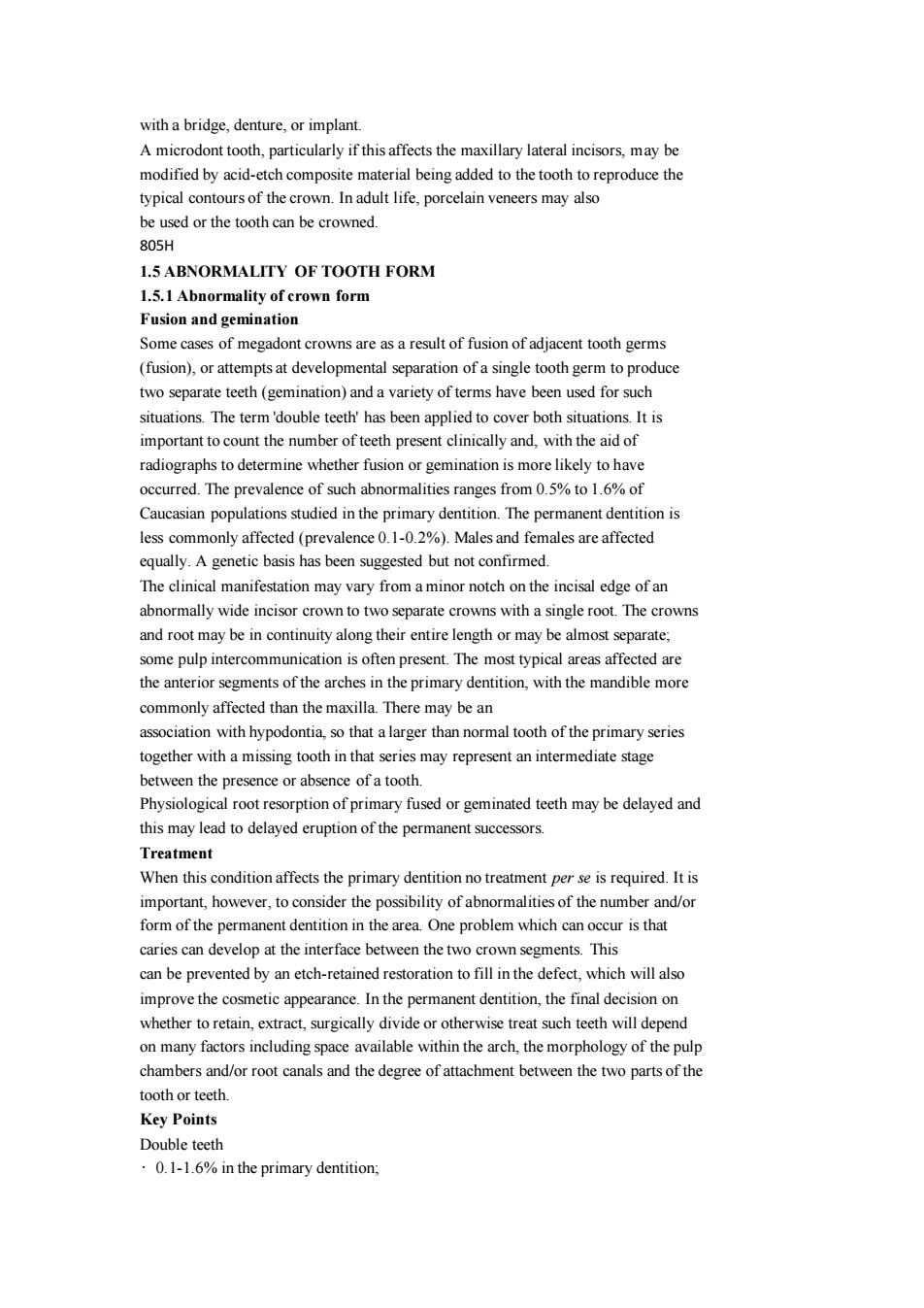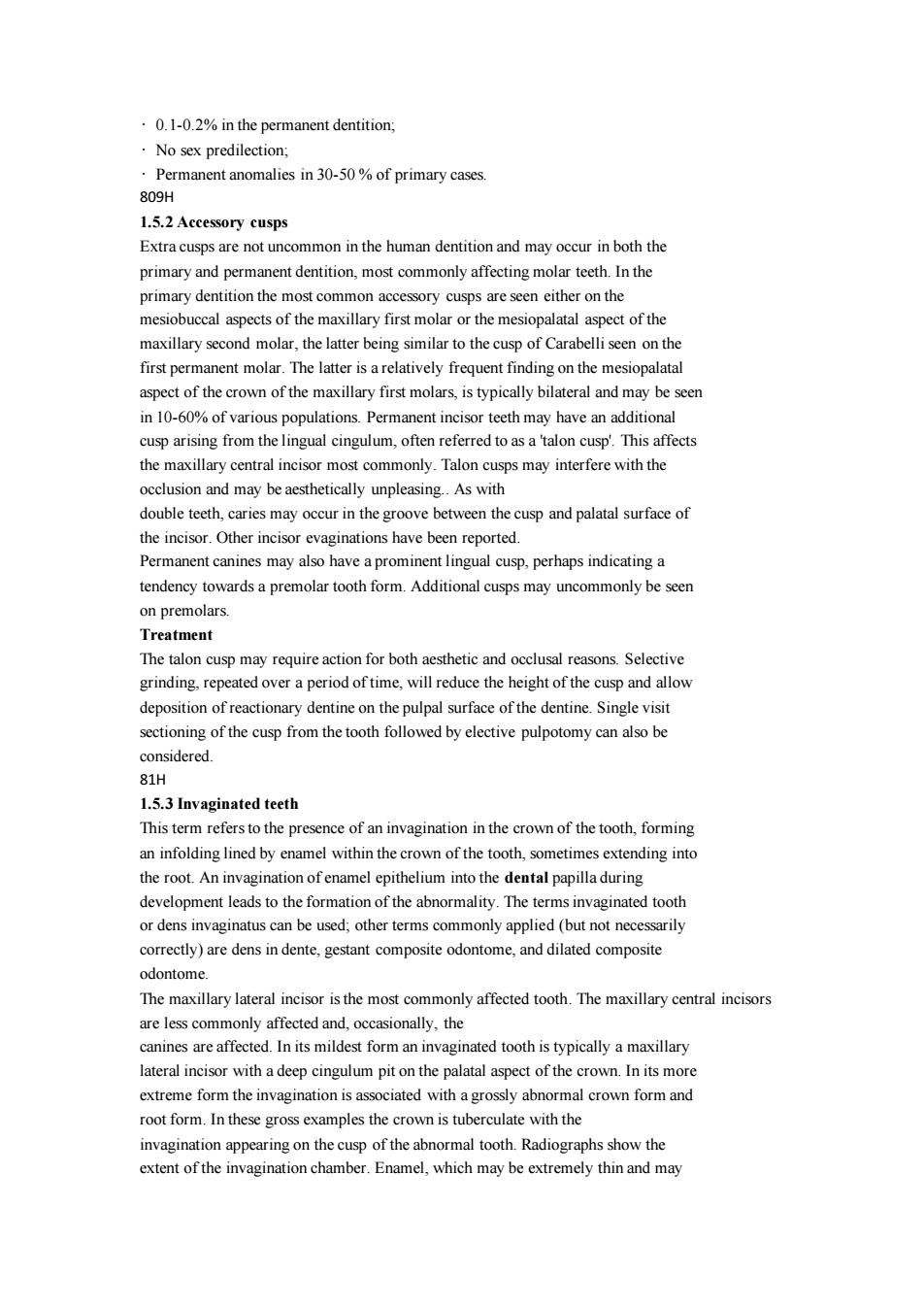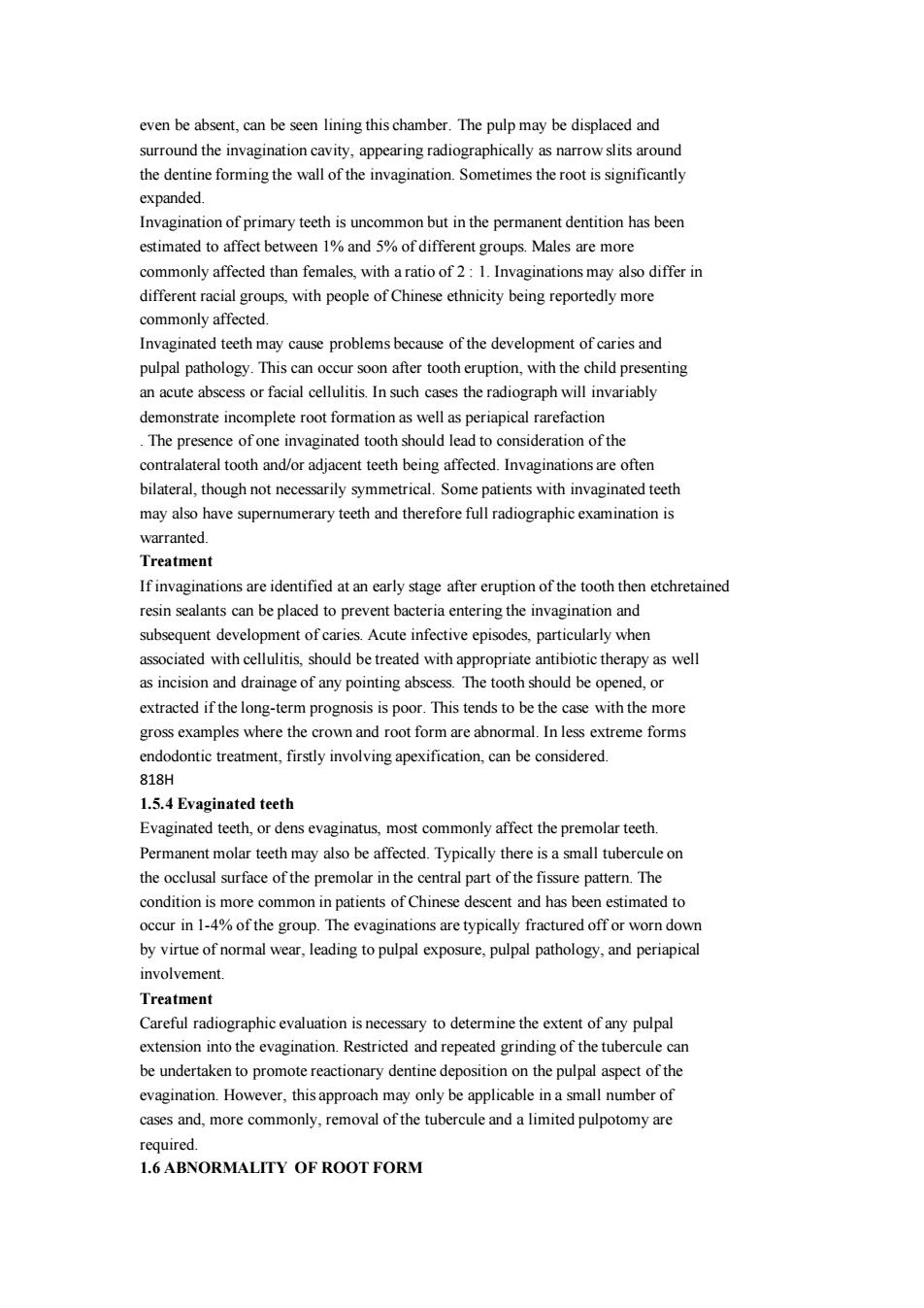
with a bridge.denture.or implant modified by acid-etch composite material being added to the tooth to reproduce the typical contours of the crown.In adult life,porcelain veneers may also be used or the tooth can be crowned. 805H 1.5 ABNORMALITY OF TOOTH FORM 1.5.1Abnormality of crown form Fusion and gemination Some cases of megadont crowns are as a result of fusion of adiacent tooth germs (fusion).or attempts at developmental separation of a single tooth germ to produce two separate teeth (gemination)and a variety ofterms have been used for such important to count the number of teeth present clinically and,with the aid of radiographs to determine whether fusion or gemination is more likely to have occurred.The prevalence of such abnormalities ranges from05%to 1.6%of less co mm sare affected equally.A genetic basis has been suggested but not confirmed The clinical manifestation may vary from a minor notch on the incisal edge of an abnormally wide incisor crown to two separate crowns with a single root.The crowns and root may be in continuity along their entire length or may be almost separate: in the ith thema ndible more commonly affected than the maxilla.There may be an association with hypodontia,so that a larger than normal tooth of the primary series ogether with a missing tooth in that series may represent an intermediate stage ence or absence of a tooth Physiolog ry fusedr geminated teeth may be delayed and this may lead to delayed eruption of the permanent Treatment When this condition affects the primary dentition no treatment perse is required.It is important,however,to consider the possibility of abnormalities of the number and/or form of the nt dentition in the problem which ecur is that caries can developat the interface between the wo own segments.I can be prevented by an etch-retained restoration to fill in the defect,which will also improve the cosmetic appearance.In the permanent dentition,the final decision on whether to retain.extract.surgically divide or otherwise treat such teeth will depend on many factors including sp available within the arch.the morphology of the pulp chambers hment between the two parts of th tooth or teeth Key Points Double teeth .0.1-1.6%in the primary dentition;
with a bridge, denture, or implant. A microdont tooth, particularly if this affects the maxillary lateral incisors, may be modified by acid-etch composite material being added to the tooth to reproduce the typical contours of the crown. In adult life, porcelain veneers may also be used or the tooth can be crowned. 805H 1.5 ABNORMALITY OF TOOTH FORM 1.5.1 Abnormality of crown form Fusion and gemination Some cases of megadont crowns are as a result of fusion of adjacent tooth germs (fusion), or attempts at developmental separation of a single tooth germ to produce two separate teeth (gemination) and a variety of terms have been used for such situations. The term 'double teeth' has been applied to cover both situations. It is important to count the number of teeth present clinically and, with the aid of radiographs to determine whether fusion or gemination is more likely to have occurred. The prevalence of such abnormalities ranges from 0.5% to 1.6% of Caucasian populations studied in the primary dentition. The permanent dentition is less commonly affected (prevalence 0.1-0.2%). Males and females are affected equally. A genetic basis has been suggested but not confirmed. The clinical manifestation may vary from a minor notch on the incisal edge of an abnormally wide incisor crown to two separate crowns with a single root. The crowns and root may be in continuity along their entire length or may be almost separate; some pulp intercommunication is often present. The most typical areas affected are the anterior segments of the arches in the primary dentition, with the mandible more commonly affected than the maxilla. There may be an association with hypodontia, so that a larger than normal tooth of the primary series together with a missing tooth in that series may represent an intermediate stage between the presence or absence of a tooth. Physiological root resorption of primary fused or geminated teeth may be delayed and this may lead to delayed eruption of the permanent successors. Treatment When this condition affects the primary dentition no treatment per se is required. It is important, however, to consider the possibility of abnormalities of the number and/or form of the permanent dentition in the area. One problem which can occur is that caries can develop at the interface between the two crown segments. This can be prevented by an etch-retained restoration to fill in the defect, which will also improve the cosmetic appearance. In the permanent dentition, the final decision on whether to retain, extract, surgically divide or otherwise treat such teeth will depend on many factors including space available within the arch, the morphology of the pulp chambers and/or root canals and the degree of attachment between the two parts of the tooth or teeth. Key Points Double teeth • 0.1-1.6% in the primary dentition;

.0.1-0.2%in the permanent dentition; Nosex predilection ermanent anomalies in30-50%of primary cases 1.5.2 Accessory cusps Extra cusps are not uncommon in the human dentition and may occur in both the primary and permanent dentition,most commonly affecting molar teeth.In the primary dentition the most usps on the mesiobuccal aspects of the maxillary first molar or the mesiopalatal aspect of the maxillary second molar,the latter being similar to the cusp of Carabelli seen on the first permanent molar.The latter is a relatively frequent finding on the mesiopalatal aspect of the crown of the maxillary first molars,is typically bilateral and may be seen in1-0%ofvariou usp arising from the populat ons Permanent in sorteeth ma elingual cingulumoften referred to as a'talon cusp'This affects the maxillary central incisor most commonly.Talon cusps may interfere with the occlusion and mav be aesthetically unpleasing.As with double teeth.caries may occur in the groove between the cusp and palatal surface of have been e manent canines may also tendency towards a premolar tooth form.Additional cusps may uncommonly be seen on premolars. Treatment require action for both aesthetic and occlusal reasons Selective riod of time,ill reduce the heig eight of the and allov deposition of reactionary dentine on the pulpal surface of the dentine.Single visi sectioning of the cusp from the tooth followed by elective pulpotomy can also be considered. 81H 1.5.3 Invaginated teeth Thisterm refers tothe pre of in the rown of an infolding lined by enamel within the crown of the tooth,sometimes extending into the root.An invagination of enamel epithelium into the dental papilla during development leads to the formation of the abnormality.The terms invaginated tooth or dens invaginatus can be used:other terms commonly applied (but not necessarily )are dens in dente,gestant composite odontome,ar nd dilat ted composite odontome. The maxillary lateral incisor is the most commonly affected tooth.The maxillary central incisors are less commonly affected and,occasionally.the canines are affected.In its mildest form an invaginated tooth is typically a maxillary deep piton the palatalaspect ofth crown.In its m extreme form the invagination with abnormal crown form root form.In these gross examples the crown is tuberculate with the invagination appearing on the cusp of the abnormal tooth.Radiographs show the extent ofthe invagination chamber.Enamel,which may be extremely thin and may
• 0.1-0.2% in the permanent dentition; • No sex predilection; • Permanent anomalies in 30-50 % of primary cases. 809H 1.5.2 Accessory cusps Extra cusps are not uncommon in the human dentition and may occur in both the primary and permanent dentition, most commonly affecting molar teeth. In the primary dentition the most common accessory cusps are seen either on the mesiobuccal aspects of the maxillary first molar or the mesiopalatal aspect of the maxillary second molar, the latter being similar to the cusp of Carabelli seen on the first permanent molar. The latter is a relatively frequent finding on the mesiopalatal aspect of the crown of the maxillary first molars, is typically bilateral and may be seen in 10-60% of various populations. Permanent incisor teeth may have an additional cusp arising from the lingual cingulum, often referred to as a 'talon cusp'. This affects the maxillary central incisor most commonly. Talon cusps may interfere with the occlusion and may be aesthetically unpleasing. As with double teeth, caries may occur in the groove between the cusp and palatal surface of the incisor. Other incisor evaginations have been reported. Permanent canines may also have a prominent lingual cusp, perhaps indicating a tendency towards a premolar tooth form. Additional cusps may uncommonly be seen on premolars. Treatment The talon cusp may require action for both aesthetic and occlusal reasons. Selective grinding, repeated over a period of time, will reduce the height of the cusp and allow deposition of reactionary dentine on the pulpal surface of the dentine. Single visit sectioning of the cusp from the tooth followed by elective pulpotomy can also be considered. 81H 1.5.3 Invaginated teeth This term refers to the presence of an invagination in the crown of the tooth, forming an infolding lined by enamel within the crown of the tooth, sometimes extending into the root. An invagination of enamel epithelium into the dental papilla during development leads to the formation of the abnormality. The terms invaginated tooth or dens invaginatus can be used; other terms commonly applied (but not necessarily correctly) are dens in dente, gestant composite odontome, and dilated composite odontome. The maxillary lateral incisor is the most commonly affected tooth. The maxillary central incisors are less commonly affected and, occasionally, the canines are affected. In its mildest form an invaginated tooth is typically a maxillary lateral incisor with a deep cingulum pit on the palatal aspect of the crown. In its more extreme form the invagination is associated with a grossly abnormal crown form and root form. In these gross examples the crown is tuberculate with the invagination appearing on the cusp of the abnormal tooth. Radiographs show the extent of the invagination chamber. Enamel, which may be extremely thin and may

even be absent.can be seen lining this chamber.The pulp may be displaced and the dentine forming the wall of the invagination.Sometimes the root is significantly expanded. Invagination of primary teeth is uncommon but in the permanent dentition has been estimated to affect between 1%and 5%of different groups.Males are more commonly. different racial groups,with people of Chinese being reportedly mor commonly affected. Invaginated teeth may cause problems because of the development of caries and pulpal pathology.This can occur soon after tooth eruption,with the child presenting n acute abscess or facial cellulitis In such cases the radiograph will invariably The presence of one invaginated tooth should lead to consideration of the contralateral tooth and/or adjacent teeth being affected.Invaginations are often bilateral,though not necessarily symmetrical.Some patients with invaginated teeth may also have supernumerary teeth and therefore full radiographic examination is If invaginations are identified at an early stage after eruption of the tooth then etchretained resin sealants can be placed to prevent bacteria entering the invagination and subsequent development of caries.Acute infective episodes.particularly when be treated witha rainage of any pointing The opened, extracted if the long-term prognosis is poor.This tends to be the case with the more gross examples where the crown and root form are abnormal.In less extreme forms endodontic treatment,firstly involving apexification,can be considered. 只1g日 1.5.4 Evaginated teeth Evaginated teeth,or dens evaginatus,most commonly affect the premolar teeth Permanent molar teeth may also be affected.Typically there is a small tubercule on the occlusal surface of the premolar in the central part of the fissure pattern.The condition is more common in patients of chinese descent and has been estimated to oceur in 1-4%ofthe group.The aginations are typically fractured dow by ear,ading to pulpal xposure pulpal pathology,and periapica nvolvement. Treatment Careful radiographicevaluation is necessary to determine the extent of any pulpal extension into the evagination.Restricted andr be undertaken to promo nthe pulpalaspect ofth evagination.However,this approach may only be applicable in a small number o cases and,more commonly,removal of the tubercule and a limited pulpotomy are required. 1.6ABNORMALITY OF ROOT FORM
even be absent, can be seen lining this chamber. The pulp may be displaced and surround the invagination cavity, appearing radiographically as narrow slits around the dentine forming the wall of the invagination. Sometimes the root is significantly expanded. Invagination of primary teeth is uncommon but in the permanent dentition has been estimated to affect between 1% and 5% of different groups. Males are more commonly affected than females, with a ratio of 2 : 1. Invaginations may also differ in different racial groups, with people of Chinese ethnicity being reportedly more commonly affected. Invaginated teeth may cause problems because of the development of caries and pulpal pathology. This can occur soon after tooth eruption, with the child presenting an acute abscess or facial cellulitis. In such cases the radiograph will invariably demonstrate incomplete root formation as well as periapical rarefaction . The presence of one invaginated tooth should lead to consideration of the contralateral tooth and/or adjacent teeth being affected. Invaginations are often bilateral, though not necessarily symmetrical. Some patients with invaginated teeth may also have supernumerary teeth and therefore full radiographic examination is warranted. Treatment If invaginations are identified at an early stage after eruption of the tooth then etchretained resin sealants can be placed to prevent bacteria entering the invagination and subsequent development of caries. Acute infective episodes, particularly when associated with cellulitis, should be treated with appropriate antibiotic therapy as well as incision and drainage of any pointing abscess. The tooth should be opened, or extracted if the long-term prognosis is poor. This tends to be the case with the more gross examples where the crown and root form are abnormal. In less extreme forms endodontic treatment, firstly involving apexification, can be considered. 818H 1.5.4 Evaginated teeth Evaginated teeth, or dens evaginatus, most commonly affect the premolar teeth. Permanent molar teeth may also be affected. Typically there is a small tubercule on the occlusal surface of the premolar in the central part of the fissure pattern. The condition is more common in patients of Chinese descent and has been estimated to occur in 1-4% of the group. The evaginations are typically fractured off or worn down by virtue of normal wear, leading to pulpal exposure, pulpal pathology, and periapical involvement. Treatment Careful radiographic evaluation is necessary to determine the extent of any pulpal extension into the evagination. Restricted and repeated grinding of the tubercule can be undertaken to promote reactionary dentine deposition on the pulpal aspect of the evagination. However, this approach may only be applicable in a small number of cases and, more commonly, removal of the tubercule and a limited pulpotomy are required. 1.6 ABNORMALITY OF ROOT FORM